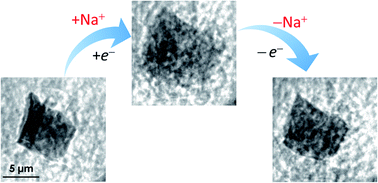Remarkable microstructural reversibility of antimony in sodium ion battery anodes†
Abstract
Bulk Sb anodes have been reported to exhibit cycle stability in sodium-ion batteries (SIBs) that is considerably superior to that in lithium-ion batteries (LIBs) and that of numerous other alloying metal anodes in both batteries. Herein, the microstructural evolution of micron-sized (>5 μm) Sb particles during (de)sodiation and (de)lithiation cycles was studied using in operando transmission X-ray microscopy. In SIBs, the Sb anode particles exhibit isotropic microstructural and dimensional variations without the formation of a new phase domain or boundary within the interior during the redox cycle, which eventually produces nearly perfect microstructural and dimensional reversibility. The anode exhibits an unprecedented size threshold among alloying metal anodes of approximately 20 μm for nonfracturing. By contrast, the Sb anode particles in LIBs suffer from extensive fractures and porosity formations. The remarkable microstructural reversibility of Sb in SIB can be attributed to its amorphous intermediate reaction pathway, which contrasts with the crystalline-intermediate pathway for the LIB. This study provides direct “visual” evidence to demonstrate the strong causal relationship between the reaction pathway, microstructural transformation, and cycle performance in metal alloying anodes.



 Please wait while we load your content...
Please wait while we load your content...